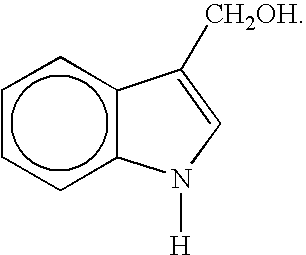Antitumoral combinations containing et-743 and a cruciferous and a cruciferous indole compound
a technology of cruciferous indole and combination drug, which is applied in the field of combination drug treatment and a method, to achieve the effects of effective treatment of tumours, and reducing hepatotoxic side effects
- Summary
- Abstract
- Description
- Claims
- Application Information
AI Technical Summary
Benefits of technology
Problems solved by technology
Method used
Image
Examples
example 1
Study of Hepatotoxicity
[0038] I3C at 0.1 or 0.5% or di-indolyl methane (DIM) at 0.2% were added to the diet of female Wistar rats (230-260 g) seven days prior to treatment with a hepatotoxic dose of ET-743 (40 μg / kg, iv. via the lateral tail vein). This amount constitutes doses equivalent to approximately 80 and 400 mg / kg I3C per day. Control animals received the unaltered diet and / or water as the vehicle for ET-743. The dose of DIM was based on the following consideration: DIM is the product of the condensation of two molecules of I3C, therefore assuming all of the I3C in the 0.5% dose group dimerises to form DIM, the maximal amount of DIM which could theoretically be generated is half of the amount of I3C in the diet. Each treatment group comprised 4 animals. Hepatic changes were studied by assessment of alterations in plasma levels of bilirubin and liver enzymes ALP and aspartate aminotransferase (AST) and by conventional histopathological investigation of liver tissue. Day thre...
example 2
Study of Antitumor Activity
[0043] For a hepatoprotection strategy involving I3C to be clinically feasible, it needs to be demonstrated that I3C does not adversely affect the antitumor activity of ET-743.
[0044] 13762 tumor fragments (100-200 mg weight) were implanted (sc) into the flank of female Fischer rats (100-120 g). Also in this rat strain ET-743 (40 μg / kg, Lv.) alone has been shown to cause changes in plasma levels of liver-specific indicators and liver histopathology identical to those described for Wistar rats in Example 1. Properties of the 13762 tumour have previously been described for example in Braunschweiger P. G., and Schiffer L. M. 1980, J. Natl. Cancer Inst., 64: 671-674: “Growth kinetics of mammary tumor 13762 in rats previously cured by chemotherapy”. Tumor weight (TW) was calculated on each day via tumor diameters, using a Vernier caliper and the formula: TW (in mg)=tumor volume (mm3)=d2×D / 2, in which d and D represent the shortest and longest diameter, respect...
example 3
Study of ET-743 Levels in Liver and Plasma
[0046] We tested the hypothesis that I3C pretreatment alters clearance of ET-743 from plasma and liver in vivo. Blood samples and liver tissue were collected from rats before and up to 24 h after administration of ET-743 (40 μg / kg iv.) with or without treatment with I3C (0.5% in the diet) given from 6 days prior to ET-743. Blood samples (by cardiac puncture) and liver tissue were collected before and at 0.5, 1, 3, 6, 12 and 24 h post treatment. Blood was placed in heparinized tubes, and plasma was obtained by centrifugation. An aliquot (0.3 ml) was mixed with 0.7 ml ammonium acetate buffer (0.2 M, pH 5.0). Liver tissue was homogenized (1:1) in water. Levels of ET-743 were measured by HPLC coupled to electrospray ionization tandem mass spectrometry in the plasma and liver samples.
[0047] I3C did not alter ET-743 disposition in the plasma or liver markedly, consistent with its un-impeded antitumor activity. The mean values for the area under ...
PUM
| Property | Measurement | Unit |
|---|---|---|
| Composition | aaaaa | aaaaa |
| Toxicity | aaaaa | aaaaa |
Abstract
Description
Claims
Application Information
 Login to View More
Login to View More - R&D
- Intellectual Property
- Life Sciences
- Materials
- Tech Scout
- Unparalleled Data Quality
- Higher Quality Content
- 60% Fewer Hallucinations
Browse by: Latest US Patents, China's latest patents, Technical Efficacy Thesaurus, Application Domain, Technology Topic, Popular Technical Reports.
© 2025 PatSnap. All rights reserved.Legal|Privacy policy|Modern Slavery Act Transparency Statement|Sitemap|About US| Contact US: help@patsnap.com


